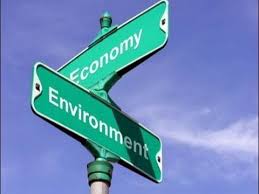For too long, dire messages and gloomy assumptions about the fate of the planet have lent an air of hopelessness to one of the biggest challenges facing society. Conservationists feel stymied. Businesspeople feel villainized. We have come to accept the view that preserving the planet and growing the economy are mutually exclusive.

But maybe this dichotomous view of human needs and conservation is itself the problem. What if advancing conservation and human development is not an either-or proposition? What if we can do better in both? The perception of development vs. conservation is not just unnecessary, but actively counterproductive to both ends. Achieving a sustainable future will be dependent on our ability to secure both thriving human communities and abundant and healthy natural ecosystems. A new study12 explores what the world will look like in 2050 if economic and human development progress in a "business-as-usual" fashion and what it would look like if instead we join forces to implement a "sustainable" path with a series of fair-minded and technologically viable solutions to the challenges that lie ahead.
The results proved what sustainability experts had predicted all along. Although a "business-as-usual" approach would sustain higher GDP growth rates in the present, it would bottom out late in the century and the world would be thrust into endless recessions and deep rooted structural economic problems that would prevent any form of recovery. Over the next 30 years, we know we'll face rapid population growth and greater pressures on our natural resources. The statistics are sobering-with 9.7 billion people on the planet by 2050, we can expect a 54 percent increase in global food demand and 56 percent increase in energy demand. And our business-as-usual analysis makes clear what many already fear: that human development based on the same practices we use today will not prepare us for a world with nearly 10 billion people.
To put it simply, if we stay on today's current path, we risk being trapped in an intensifying cycle of scarcity-our growth opportunities severely capped and our natural landscapes severely degraded. Under this business- as-usual scenario, we can expect global temperature to increase 3.2°C; worsened air pollution affecting 4.9 billion more people; overfishing of 84 percent of fish stocks; and greater water stress affecting 2.75 billion people. Habitat loss continues, leaving less than 50 percent of native grasslands and several types of forests intact3. This situation is certainly not one which could lead the world through decades of economic growth and prosperity.
However, when we consider approaches such as the "Green New Deal", it leaves us with a peculiar problem - huge unemployment, economic revolution, overthrowing of a centuries old economic system, and massive structural earthquakes. Plans such as those wish to implement a carbon free world by 2030 by shutting down every activity that generates carbon, imposing a herculean carbon tax upon companies and causing millions to find themselves on unemployment benefits. Are such plans the way to proceed? Certainly not. The plan declared intentions to shut down the automobile, airline, fracking, drilling, mining, and countless other industries that serve as the very foundation of the modern world economy. Such an approach would leave the world economy in tatters in the present with hope that there would be economic prosperity in the future.
Although a tradeoff seems imminent considering the arguments presented hitherto, the purpose therein had been to underscore the importance of finding a solution that balances the two fundamental issues of economic growth and environmental protection. Although the Paris Climate Agreement went a long way in defining an approach that would lead to continued economic prosperity at an environmentally sustainable level, it should never be confused as the final solution; no, it serves as the basis of plans that need to be developed. In the modern political and economic structure, real progress does not take place through revolutions or stagnation; it takes place through consensus, pragmatism, and achievable goals. A perfect balance can only be struck by actions that acknowledge that structural economic change is slow but powerful and needs to be conducted with care and precision, while being ambitious and bold in tackling the environmental crisis at the same time. A perfect balance is needed to ensure that the world economy protects the consumption patterns of the future while not depriving us of ours.